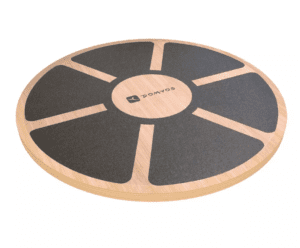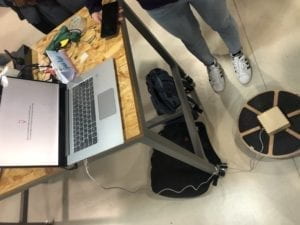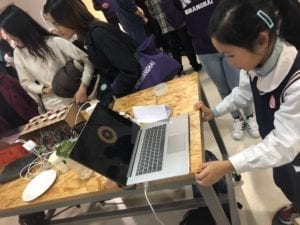CONCEPTION AND DESIGN:
When my partner and I were making design decisions, we first wanted to make our project a piece with a deep meaning. Influenced by my peers’ ideas which are all very “profound,” we also want to make our project a statement piece, or an experience that would educate people in the end. We proposed ideas like a game that would educate people on the unnecessary nature of social media and various other apps, but we struggled to create an engaging experience that would show our purpose. After consultation with Professor Marcela, my partner and I realized the more important thing about our project should be the experience itself. If we can create a new type of experience that is really interactive and engaging, we do not have to add some grand purposes to our project. Inspired by Marcela, we decided to focus on new forms of interaction – new experiences. Cathy suggested using the balance board for the user to stand on, and it turned out to be a great idea for our game by going beyond the usual keyboard experience. Our idea is to engage the entire body of the user, instead of merely part of his/her body like the fingers, so the balance board is really a great tool to realize that. Furthermore, the balance board is originally used in the gym, which adds another layer of meaning to our game – have fun while training your balancing ability! To suit the swinging nature of the balance board, we decided to use the sensor accelerometer to detect the user’s movement. We wanted to design a game that would require the user to constantly swing the board while keeping the balance – a fun way of interaction.

FABRICATION AND PRODUCTION:
In the production process, we first wanted to do the digital fabrication. At first my partner and I were thinking about making the balance board through 3D printing ourselves. But after consultation with Andy we realized the materials we have might not be so strong to sustain some users’ weight on the board. So we directly purchased a balance board and decided to do laser-cut a small box to put on the board. We hid the Arduino and sensor inside the box. The box serves as a protection from the user’s feet, which later in the user-testing was very important.
After the digital fabrication, we focused on testing the sensor and the code for the game. We were completely unfamiliar with accelerometer, but thanks to Tristan and Marcela’s help, we downloaded the guideline from the Internet and kept trying to make the sensor right. At first we were unable to detect the changes of the x and y values regardless of how we tried. We later discovered that it is because one port of the sensor was not working. After changing a new sensor and following the guideline, we managed to put the sensor in order.
Then we focused on designing the game. We wanted to use the round shape of the board in our game too, so we were thinking about the life-saving board in the sea at first. We also make the main figure a piglet from Winnie the Pooh. But later Marcela reminded us that we need to create a scenario for our game to better engage the user. So we created a space scenario where the balance board was a future vehicle in the space, and the piglet wearing a space helmet was exploring the space. Where the piglet goes is controlled by the user standing on the board – whichever direction he/she leans to, the piglet moves in the same direction. The moving board in the space is the safe board which the asteroids cannot hit. The piglet would love to have some fun outside the board, but it cannot stay outside for too long because it needs to breathe – after 5 seconds outside the board it dies from suffocation. Or if it gets hit by the moving asteroids directly, it dies instantly. In order to create the atmosphere of this scenario, we decided that the background should be the space. But inserting a image directly would cause the processing to progress too slowly. We tried to fix the problem but Tristan told us there is no easy solution. So I made a relatively simple but nice black background with shiny yellow stars scattered in it. This helps our game run smoothly. Thanks to my partner Cathy, we managed to make the code for the bouncing asteroids right. Although the sketch seems simple, it has the basic elements of a space game.
The user-testing session is very helpful. The users liked our idea of the moving board, and we collected much feedback for modification, such as the speed of the traveling piglet should be faster to make the game more engaging, the moving board can become smaller as time goes by, the moving boundary of the board can be expanded, and the placing of the wire should be switched to make it easy for the user to stand on. About the game concept, users also suggested we creating a game scenario that involves more elements, like bonus scores for “reaching” some stars for the piglet, and the showing of the time limit for the piglet staying outside the board. Marcela also suggested we adding sound to the game in our presentation, which adds a lot more to our game. We took almost all of this advice and modified our game base on that. The changes make our game more complete and engaging. One user also suggested making the fabricated box smaller and moving the Arduino onto the table instead of on the board, but we did not follow that because we had limited time and thought it was more important to focus on the game itself.


CONCLUSIONS:
The goal of my project is to create a new game experience that involves the movement of the user’s entire body. By standing on the balance board to control the movement of the piglet, the user tries to stay balanced as well as engage in the game to make sure the piglet survive as long as possible. The project aligns with my definition of interaction in that the user needs to constantly react to the changing location of the board and asteroids in the game to adjust the location of the piglet. What stands out in our project is that the extended experience is really novel – users have fun interacting with the game while shaking on the board. Ultimately, in the final show, many users tested our game and liked our idea of using the balance board. Some offered suggestions of improving the details of our game setting and code, but most of them find standing on the board very entertaining. One area we can keep working on is that the movement of the board becomes predictable after the user gets familiar with the game. We can randomize the movement of the board or speed it up – dividing the game into several rounds depending on the speed of the movement, so that the game can be more exciting and challenging.
In the production process, I came to realize the importance of exploring on our own. For example, the accelerometer sensor which I had no idea how to use can actually be mastered by self-learning online. The project can be complicated and what we learnt in class maybe insufficient, but we can always try to explore how things work ourselves and seek for help. The ability of self-learning is important in creating something of our own.
From the successes and failures of doing the final project, I also realized the importance of user “experience.” For both the project conception and the game design, we all need to create a scenario that serves the experience of the project. It is the experience that matters most for the user, and creating new forms of interaction really brings new experience and new feelings to the users. What we can further explore is how to inspire such new experiences, either by involving different parts of the human body like we did in our project or by other means. The combination of human body and new technology is very interesting and explores the new human need in the context of new technology today. Humans constantly want new forms of interaction with the technology to extend their conventional human experiences.